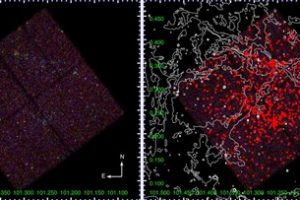Recent study on the star cluster Dolidze25 suggests that protoplanetary disks disperse more rapidly in low-metallicity environments

Protoplanetary disks are disk-like structures that are found in low-mass stars younger than 10 million of years, typically called “pre-main sequence stars”. These disks are also the sites where planets formation occurs. In the last years, scientists have devoted a large effort to study the evolution and dispersion of protoplanetary disks. This has been possible also thanks to facilities such as ALMA which, thanks to an unprecedented angular resolution, have produces detailed images of several nearby protoplanetary disks. Besides, thanks to the development of the exoplanetary science, we understood that the presence of planets is a common property in the stars of our Galaxy.
In the last decades several authors have calculated the fraction of stars with protoplanetary disks in stellar clusters with different ages. Thanks to these studies, we know that disks disperse quite rapidly: in stellar clusters as old as 5 million years the fraction of stars still hosting a disk is quite low. This evidence set an important upper limit to the time available for planets formation. Besides, several studies demonstrated that in given star-forming environments disks can disperse even quicker, and that in the most extreme cases planets may not have enough time to form. This occurs in environments with an intense local UV field, produced by a rich population of massive stars, or characterized by high stellar density. These properties are typical of the cores of intermediate massive clusters, such as NGC 6611, the cluster in the well known Eagle Nebula, or highly populated OB associations, such as Cygnus OB2.
Dispersal timescales of protoplanetary disks may also depend on the metallicity of the star-forming environment, which is the abundance of elements heavier than hydrogen and helium. Several disk properties, in fact, are set also by metallicity, such as the abundance of dust grains and the opacity, which is the capability of absorbing stellar radiation. However, these environments are typically at large distances, and thus difficult to study. The exception to this is the young (about 1 million year old) stellar cluster Dolidze 25, about 15000 light years from us, which is characterized by low metallicity. From the analysis of archival optical and infrared data, together with a specific X-ray observations obtained with the NASA satellite Chandra, the team led by M. G. Guarcello (INAF – Astronomical Observatory of Palermo) identified 1091 stars associated with Dolidze 25, and calculated that about 34% of these stars still hosts a disk. This fraction is quite low if compared with that observed in coeval low-mass clusters, being actually similar to the values observed in clusters where disks are rapidly dispersed because of the surrounding environment. This result is quite important, since it suggests that disks lifetime may depend on metallicity, which, in turn, changes in our Galaxy both as a function of the distance from the Galactic center, and from the epoch. The study is described in the paper: “Dispersal timescale of protoplanetary disks in the low-metallicity young cluster Dolidze 25“, recently appeared on Astronomy & Astrophysics.
The figure (click here to visualize the entire image) shows the fraction of stars with disks in 58 stellar clusters with age between 0 and 10 million of years, as a function of cluster age. The clusters closer than 3300 light years from the Sun are marked with large black circles, those rich of massive stars with red dots, those with extremely low metallicity with green circles. The fraction observed in Dolidze 25 is marked with a star symbol.
Mario Giuseppe Guarcello ( follow mguarce) ( youtube)
Subscribe the Youtube of the Astronomical Observatory of Palermo
